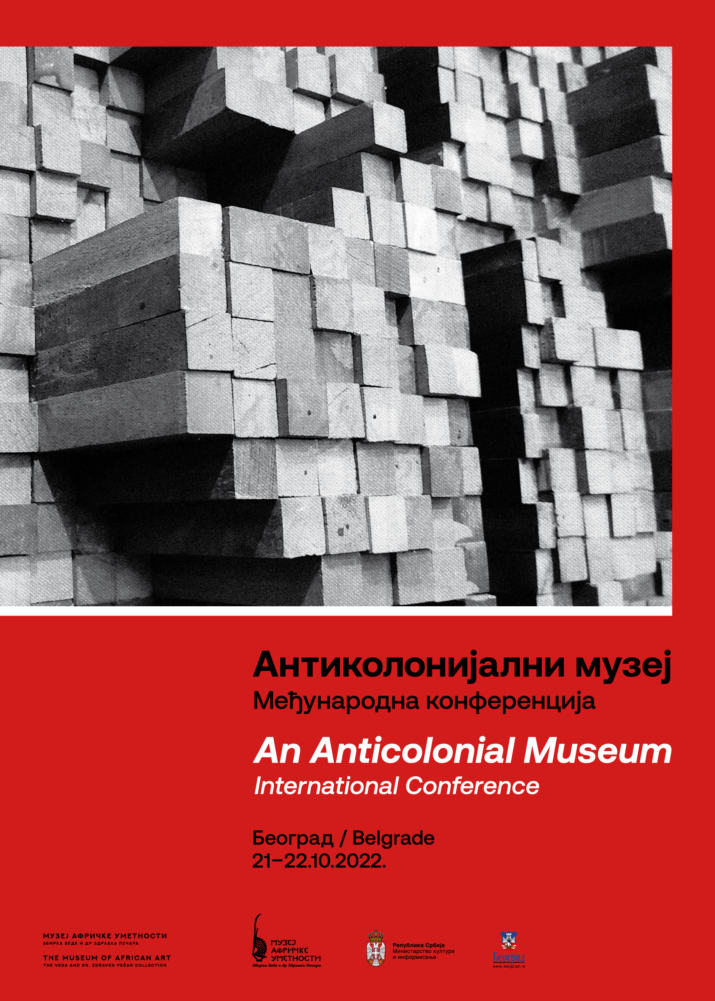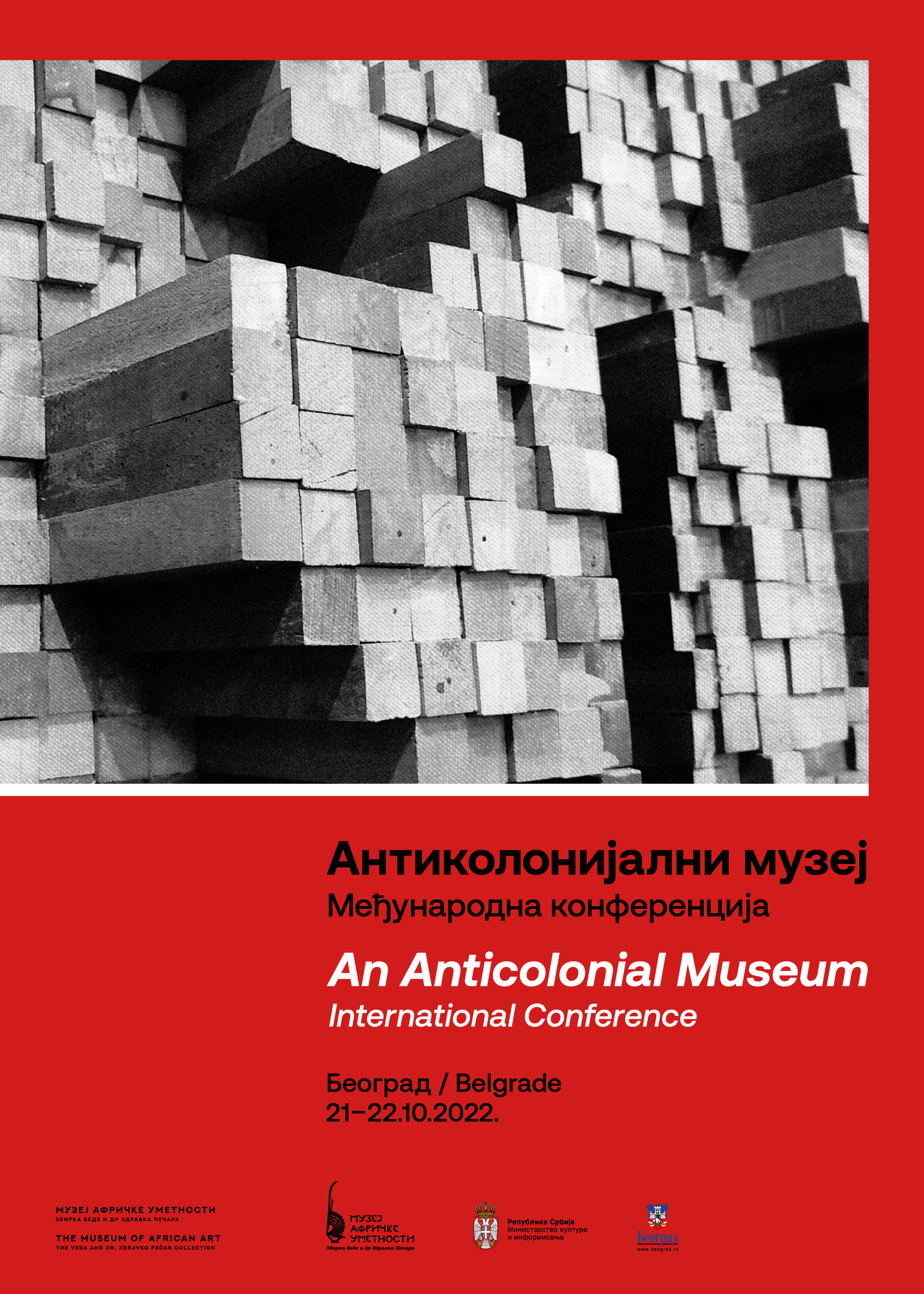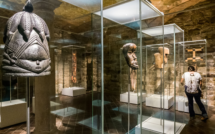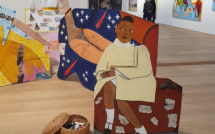
 This is part of our special feature, Decolonizing European Memory Cultures.
This is part of our special feature, Decolonizing European Memory Cultures.
The international conference “An Anticolonial Museum” was a two-day event held in Belgrade, Serbia, at the Museum of African Art – The Veda and Dr Zdravko Pečar collection (hereinafter, the MAU).[1] Taking place on October 21 and 22, 2022, the conference was conceptualized as an extension of the exhibition by the same name, which opened on September 8, 2022, and was curated by art theorist and independent curator Ana Sladojević.[2] The conference hosted live and virtual presentations by ten artists, scholars, theorists, curators, and art producers. Some of them are independent, others institutionally-based actors: Amina Zoubir (Algeria/France), Mwana Pwo (Angola), Elizabeth Asafo-Adjei (Ghana), Vitjitua Ndjiharine (Namibia), Blessing Bee Azubike (Nigeria), Jelena Savić, Jelena Vesić, Ana Vujović (Serbia), Katarina Zdjelar, Koštana Banović (based in the Netherlands), Dubravka Sekulić (based in Great Britain). Despite its small size, the conference gathered an impressively heterogeneous group of individuals who are all involved in deliberating, questioning, problematizing, and acting in different aspects of museums: exhibition production, representation, and contemporary critical theory.
The speakers comprised a diverse group spanning and merging fields of expertise such as curatorship, activism, art production, and art and culture theory. Indeed, this mix was the deliberate effort of the conference’s academic and organizational board (Ana Sladojević, Bojana Piškur, Katarina Živanović, Emilia Epštajn, and Ana Knežević) to create a shared platform for artists and independent theorists to actively critique museums. Their comments and feedback shed light on pressing issues regarding ethnographic museum collections and exhibiting methods and practices, as museums across the world have reacted to different calls to decolonize (i.e., to center the voices of people whose material culture or contemporary art is exhibited in representations of their own identities). In short, the conference aimed to bridge the professional gaps between scholars, researchers, artists, and curators and use the museum as a meeting space for different experiences and expertise and for communication with the public.
In her introductory speech, conference chair Ana Sladojević[3] stated that the conference was an opportunity to expand on the theoretical premise of the “anticolonial” museum, a point of departure for thinking about museums in today’s cacophonous world as “platforms for critical thinking and acting in real time.” Sladojević reminded participants and the audience of the MAU’s unique heritage of anticolonialism, antiracism, and solidarity with African countries. These values stemmed from the historical reality of Yugoslavia’s internationalism and the global Non-Aligned Movement (NAM). However, she insisted that the anticolonial tradition does not therefore exempt the museum from a decolonizing agenda. The two terms must be understood as both complementary and contrastive. Putting the two terms in relation, she called first of all for producing “nuanced institutional histories that do not allow all museums to be de-colonized in the same way,” and secondly, for recognizing that museums are “highly political and ideological institutions” that should “openly declare the values they stand by.” Sladojević forcefully asserted as one of the main aims of the conference that all museums—even an anticolonial museum like the MAU, with its historical rootedness in the NAM—must confront their embeddedness in colonialism and nineteenth-century imperialism. She asked conference participants to reflect on whether and how museums can overcome that legacy.
Aside from actively creating specific discourses that stem from inherited imperial and colonial institutional frameworks, museums also enable the erasure and invisibility of certain data, protagonists, and narratives. Although the de-colonization of museum work is primarily understood by the public as the return of museum objects resulting from imperial and colonial conquests to countries of origin, a far more complex issue is the decolonization of institutional knowledge production.
Ultimately, these current issues are at the heart of the broader debate about how to decolonize museums worldwide.
Conference panels emphasized pressing questions in the field of institutional knowledge production and reproduction, and the ways a certain dominant epistemological violence is committed through official heritage narratives and via institutional representation (Heritage & Violence: Unraveling the Museum as an Image of the World); recognized “un-official” remembrance practices, activities and actions, as well as their occasional “intrusion” in different museum contexts (De-centered Modernisms: Counterhistories as Alternative); and finally, created space for epistemologies lived and theorized by certain marginalized groups and individuals (Resistance from the Fringes: Recognizing A New Paradigm). The final session titled “An Anticolonial Museum: Acting in Real Time” brought all presenters to the stage, opening a discussion around some of the main conference themes.
For clarity, this review is organized in three sections: the first showcases artists as archival intruders and as researchers, whose critical approaches to colonial institutional narratives and practices, break boundaries between theory and practice. The second section illustrates current work by artist-curators and cultural producers in Ghana, Angola and Nigeria. The last section aims to draw concrete conference conclusions, highlights theoretical discussions around museum decolonization, and reflects on the MAU’s anticolonial heritage.
Artist/researcher as archival intruder
A significant number of conference contributions revolved around the notable centrality of artists who critically engage with museum archives, as invited institutional intruders, so to speak. Visual artist and videomaker Amina Zoubir reflected on her position as artist-researcher working closely with archival materials in several Western ethnographic museums containing records of the colonization of the African continent. She confessed that her encounter with blatant images of abasement and violence in the archive kindled in her the wish to “destroy the archive” and the remains of imperialist and colonialist actions and ideologies it holds. Instead of destruction, however, she turned to deconstruction, exemplified by her three diptychs titled Mamounia (2021).[4] Ultimately, she argued that the colonial archive should be preserved “as an object even if it consists of painful images.” She claimed that the archive can be reused and reinterpreted through decentered ways of seeing, and reworked in different artistic mediums of expression. Zoubir insists on creating a voice and channeling the subjectivity of people she encounters in the photographs. She accomplishes this in a material sense through the act of cutting, dissecting, and reshuffling archival images, thereby disrupting colonial narratives. She concludes that the archive places before each individual the “duty of memory” and the potential to relearn one’s own history.
Similarly, Namibian visual artist Vitjitua Ndjiharine tackles the collections and archives of ethnographic museums as both artist and researcher. At the MARKK Museum in Hamburg, Germany, for instance, she discovered how white identity was historically constructed through documentary photographs from and of Namibia (once the German colony of Deutsch-Südwest Afrika). Her methodology involved three distinct archival interventions: She digs through and mines museum categories and classifications; she undertakes “critical smuggling” of dangerous ideas that destabilize the norm (a practice also evidenced in Amina Zoubir’s work of cutting, dissecting, and reshuffling old contexts); and she advocates “curativity”— which merges curating and curing traumas—as a form of undoing that leads to reimagining different ways of living in the present and projecting a futurity.
One of the short films included in An Anticolonial Museum was Reading Museology (2017), was by Koštana Banović, a Sarajevo-born artist based in Utrecht, the Netherlands. Banović’s film was one of the early works to offer a visual experience of the history, everyday reality, and non-aligned heritage of the MAU. In a poetic rendering of Gaston Bachelard’s Poetics of Space, she created an experience of this museum as a memory palace of sorts—with an attic and a basement, i.e., storage spaces as subconscious and potential spaces that contrast with the museum’s architectural face, or façade. The unfinished walls of the dome appeared to her “like abstract paintings” and the museum as a boxed object; indeed, she experienced the museum as if it were in a state of preparation and becoming. Her video also recontextualized the ethnography of the permanent display by focusing on objects against a soundtrack of echoing recordings of the First Non-Aligned Conference held in Belgrade (1961).
Yugoslav-born artist and research Katarina Zdjelar is an educator/tutor at Piet Zwart Institute (MA Fine Art), WdKA Rotterdam, and MAR (Master Artistic Research) at the De Nederlandse Filmacademie in Amsterdam. She is also a veteran archival intruder. Zdjelar focused her presentation on two artworks as early examples of museum critique, both of which were on view at the time of the conference. The single-channel video My Lifetime (Malaika) 2012 focused on Ghana’s National Symphony Orchestra recorded in the National Theatre in Accra. This orchestra was an early post-independence national project launched by the first president of independent Ghana, Kwame Nkrumah. However, the work that more closely related to the conference’s topic was Into the Interior (Last Day of the Permanent Exhibition) from 2014, which was part of the exhibition An Anticolonial Museum. It is based on footage of the dismantling of the permanent exhibition at the Royal Museum of Central Africa (RMCA) in Belgium in 2013; the RMCA had been described as the “last colonial museum in the world.” With her two-channel video, Zdjelar morphs into artist-witness to some of the last moments of the Tervuren museum’s permanent display, marking the end of an era. Like the permanent exhibition of the MAU in Belgrade, the RMCA had remained largely unchanged since it first opened in 1910. Zdjelar spoke of the MAU’s presumed anticoloniality as a “constructed science fiction,” built upon inherited and obsolete categories. She stressed the need to contest and critique certain images and narratives: “we have inherited something, but it is our task to interact with that particular inheritance, not to affirm it.”
Zdjelar’s insight brought all three “artists in the archive” together by recognizing that museums have failed to do the kind of critical, decentered research necessary for the reinvention of institutional narratives and legacies. That failure results not necessarily from the resistance of professional staff, but from institutional mechanics, which are slow and conservative. By contrast, artists are sensitive to and able to act upon “the task of our time.” Artists are less dependent, better equipped and faster to see the histories and potentials that have been omitted from (not only museum) archives. Zdjelar saw the artist in the archive as a response to the call to hear and see what has not been heard or seen in the archive. Ultimately, Zdjelar envisioned a cross-generational dialogue about inherited ideas and worldviews.
Heritage preservation and art-activism in real-time
Artist and curator Elizabeth Asafo-Adjei’s recent work focused on mounting the exhibition “Unsettling the Dust – The Kofi Antubam Exhibition.” It was organized by the Ghana Museums and Monuments Board (GMMB) and set up at the Museum for Science and Technology in Accra. First, Asafo-Adjei offered a biographical overview of Antubam, his artistic training, and path to becoming one of the official artists invited by President Kwame Nkrumah to create Ghana’s national identity after independence. Among other works, he completed several important mosaics and murals, most notably the mural decorating the façade of the front entrance of the former Accra Community Centre, which is now the A.M.A. Maintenance Office. The mural includes an inscription in the Ga language that refers to unity, coming together, and harmony in the uplifting pan-Africanist vernacular of the times. Besides offering first-hand insight into current heritage projects in Ghana, Asafo-Adjei addressed this particular mural by presenting it side by side with a photograph from the MAU photo documentation depicting the very same building in the early 1960s, when it hosted the Afro-Asian Conference titled “Peace and Security in Africa – No Nuclear Imperialism.” This juxtaposition revealed the need for the MAU to work on research exchange projects between Ghanaian and MAU curators, researchers, and artists for the purpose of tracing NAM remembrance(s) in the Yugoslav and Ghanaian contexts.
Blessing Bee Azubike, cultural consultant, curator, arts manager stationed in Abuja, Nigeria referred to her support of Nigerian artists and cultural production as art-vocation. Azubike’s presentation offered a valuable opportunity to hear firsthand about Nigeria’s contemporary art scene. Azubike spoke about her work as production manager at the Lagos Theatre Festival and director at TALK Residency (an art residency for visual artists which she runs in Lagos Nigeria). She has also been involved in The Artist Ladder platform, which provides support, opportunities, education, and career advancement for Nigerian artists and people in the creative industry. The fact that institutional financing is still rare for artists in Nigeria makes Azubike’s grassroots cultural activism even more important. Her presence via Zoom highlighted the need of any museum that deals with the heritage of and from the African content (including the MAU), to directly involve people working in different contexts. The conference was also a special occasion to hear artist Mwana Pwo from Benguela, Angola, who presented her work from the past decade, in which she predominantly used photography to commemorate personal experiences. Her recorded memories contributed to recent investigations of Portuguese colonialism and its aftermath in Angolan society. Her talk offered insights into the vibrant Angolan contemporary art scene, especially in Luanda, and explained how African artists navigate the global contemporary art scene, where they often have to adapt their personal biographies and collective identities to pre-existing notions of what an African artist is expected to be and create.
Theory in practice and practice in theory
The theoretical sections of the conference offered more critical viewpoints regarding Yugoslavia’s anticolonial heritage. Architect, theorist, and educator Dubravka Sekulić critically challenged the way in which Yugoslav anticolonialism and antiracism became implicated in modernization projects through professionalization, when Yugoslav architects and engineers worked in Africa during the 1960s and onwards. She focused her observations on one of the former country’s leading construction companies, Energoprojekt. Sekulić critically exposed Yugoslav exoticism and the tendency to reproduce inherited (colonial) standards and worldviews. This criticism also applies to the anticolonial MAU in Belgrade (see Ana Sladojević’s contribution to this issue). Sekulić recognized the need for the MAU to undo and unlearn a certain type of consciousness best described as Yugoslav anticolonialism, which, despite being antifascist and founded in solidarity still betrayed exoticism in architecture, revealing certain fixed and inherited (colonial) standards. Sekulić recognized that colonial museums “at best” hide behind a form of neutrality embedded in white innocence, and offered several suggestions that could be valuable for practicing the idea of an anticolonial museum: if the colonial museum is “the site par excellence of the production of the subjectivity of whiteness,” then an anticolonial museum is a museum committed to becoming a space of unlearning and abolishing white privilege. In the process it is unlearning itself as an imperial technology.
Jelena Savić, a Roma theorist, feminist, activist and poet, cautioned against blanket decolonization. She provided a critical understanding of Serbia’s NAM (Yugoslav) legacy as a place for the harboring of both color blindness and race exceptionalism. Indeed, she offered insight into her ongoing theoretical writing about the “darker side of Eastern-European post-coloniality” and European Gadjo supremacy (gadjo being the Roma term for non-Roma). According to Savić, where there is white privilege, there is (specifically) Gadjo privilege; where there is white fragility, there is also Gadjo fragility. This erasure amounts to a seemingly “neutral” scientific racism in both the domestic and international academic worlds. As a Roma theorist, she understands the usefulness of the legacy of NAM, but maintains that this legacy must be scrutinized to avoid three troubling effects of intellectual colonization on Roma heritage and realities. The Roma are either not mentioned, framed as Gadjo stereotypes of Roma, or confined to footnotes )rather than the main text), which Savić compares to “epistemic slums” mirroring living conditions in actual European slums.
From producing knowledge to transforming the museum
Conclusions in the final session were moderated by conference chairperson Ana Sladojević, accompanied by Jelena Vesić, an independent curator, writer, editor, and lecturer. They were joined in a final discussion by participants of the two-day conference, in person and via zoom.
Ana Sladojević briefly summarized some of the conference main insights: the need for “art for a reason” and more grassroots initiatives that recognize specific needs and directly result in organised collaborative effort (the work done by Blessing Bee Azubike in Nigeria); the criticism of petrified forms of decision making in museums; and the observation that museums function as science fiction we continue to believe (Sekulić; Zdjelar).
Vesić recognized two further red threads running through the two-day conference, namely the interaction of artists with museums or archives for the purpose of social transformation, and secondly the vision of museums as centers of knowledge production. Vesić further noted as reoccurring themes the reductionist practice of othering that still occurs in curating and exhibition-making, and the persistent attempts to pigeonhole artists within predetermined ethnic, geo-political, religious, gender (and many other) socio-political identity categories. Finally, Vesić posed the important question of the so-called archive fever, and asked why there is such an interest among artists to enter museums and work on archival materials, but not among curators and experts working in museums today.
Sladojević concluded that museums continue to produce an image of a world that is a reflection of only those who have the power and means to create it. The future of museums lies in their ability to create social and psychological safe spaces, exemplified by the MAU’s construction of a space that deals with “our Serbian/Yugoslav historical selves, not African art, and there is a strong need to critically recuperate this image of our historical selves.” She ended by posing the question: can we think of museums as places of healing? Her answer was Yes—because all of the methodologies we witnessed over the course of the conference all engage with museums in transformative ways.
In the end, the conference raised the following question: is it possible, from the perspective of museum work, to move from knowledge production to fostering and practicing critical thinking, among professionals, collaborators (artists, curators, researchers) and the public? What activities, talks, actions, or programs would contribute to the decolonizing of museums and ethnographic collections? Vitjitua Ndjiharine’s vision may help us reach certain conclusions and obtain practical advice for transforming museums. Ndjiharine underlined the need to step outside of narrative, even out of theory, on the basis that she is “tired of the constant misrepresentation, blatant lies, and things that literally affect lives.” She was determined to convey that the effects of museum knowledge production are not abstract but have actual, physical, and literal effects on humans and their bodies—effects that compromise the safety and well-being of actual, living people. From a more personal point of view Ndjiharine was able to relate to radical impulses that invite “burning down the archive.” However, she primarily focused on the possibility of transforming the archive and the museum along the lines of Richard Watermeyer’s notion of the post-museum: what if museums simply opened EVERYTHING, letting people walk around without trying to control their reactions and the narratives, and thus created spaces in which one could simply wait and see what happens?
Emilia Epštajn earned her BA in Ethnology and Anthropology at the Faculty of Philosophy, and Masters Degree in Cultural and Gender Studies at the Faculty of Political Sciences (University of Belgrade). She works at the Museum of African Art in Belgrade and is executive board member of ICOM Serbia. Recent exhibitions include: “Reflect #2 – Fragments, Fragilities, Memories: Contemporary Art from Angola” (2022), “Non-Aligned World” (2021), “‘This is Not a War’ – Liberation of Mind and Land, in Ink and in Action” (2021), and “Everyday Poetics – Instagramming Life in East Africa” (2019).
References
[1] The conference is available online: https://mau.rs/en/58-news/upcoming-events/1940-an-anticolonial-museum.html
[2] The conference was also part of the wider “Re-conceptualization of the Museum of African Art – The Veda and Dr. Zdravko Pečar Collection” project (2021–2023), initiated by the forthcoming reconstruction of the MAU in Belgrade, for the first time since its opening in 1977.
[3] It is noteworthy to mention that the involvement of Ana Sladojević as out-of-house associate has instigated and motioned several MAU projects, whose evolvement can be recognized to have reached the An Anticolonial Museum exhibition and conference in 2023. Ana Sladojević was the first to critically open the question of the MAU’s anticoloniality with her 2013 doctoral dissertation “The Museum of African Art: Contexts and Representations” (available online: https://mau.rs/images/publications/Epublications/Muzej_africke_umetnosti_konteksti_i_reprezentacije/Ana_Sladojevic_Muzej_africke_umetnosti_konteksti_i_reprezentacije.pdf); and to further develop the theory through the talks series “Context and Representations,” recorded and held at the MAU during 2014; the exhibition (2017–2018) and publication (2017) “Nyimpa kor ndzidzi – One Man, No Chop. (Re)conceptualization of the Museum of African Art – the Veda and Dr. Zdravko Pečar Collection.” Acting as program coordinator and sometimes co-curator with Sladojević has been a way of materializing and testing the practical applicability of certain theories within the MAU/museum context.
[4] Amina Zoubir arrived in Belgrade and to the Museum with her three diptychs entitled Mamounia, which explore the “naked” brutalization committed on the bodies of colonized humans (woman, men and children alike). Mamounia is a powerful work of archival “dissection” (cutting and re-arranging) as an attempt to re-claim the narrative and power to organize images. This artist’s subversion focuses on the way violence is re-committed in the archive with each viewing. Immediately, the conferences organizational team decided to include the works in the permanent museums display, thus offering a critical understanding of the borders between seemingly “neutralized” museum representation, and the necessity to include the voice of the subject(-ed) artist.
Published on February 21, 2023.




